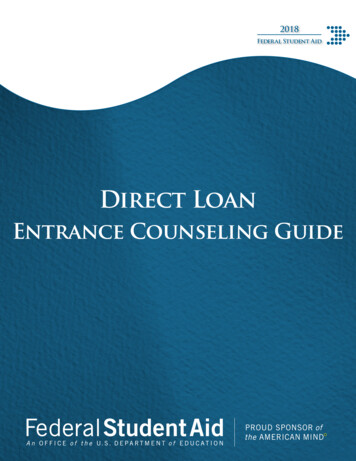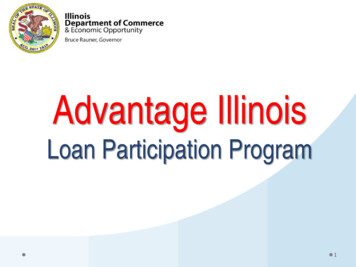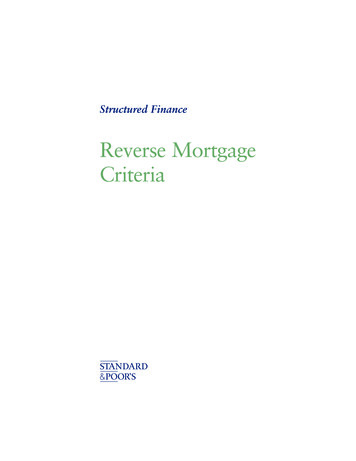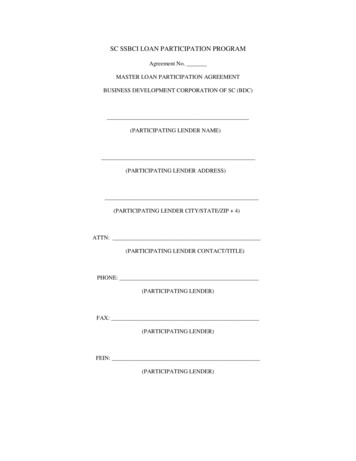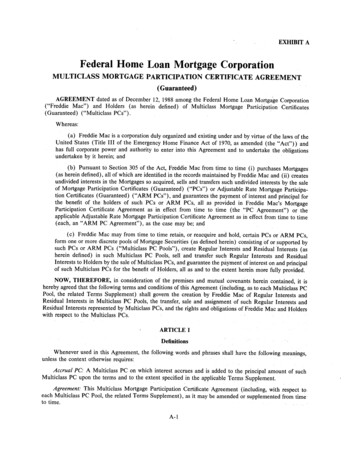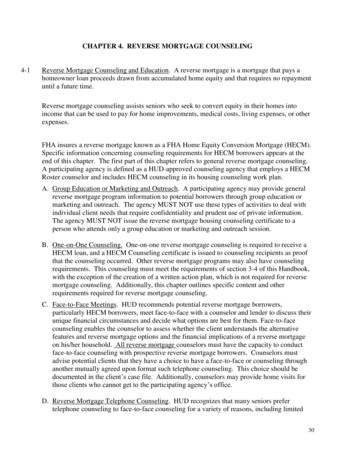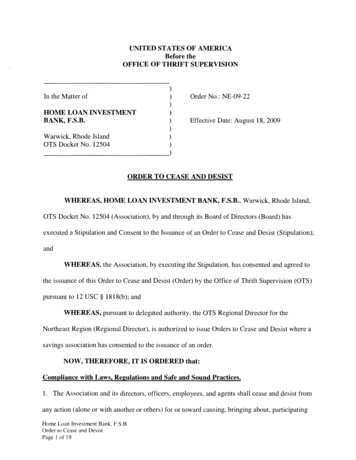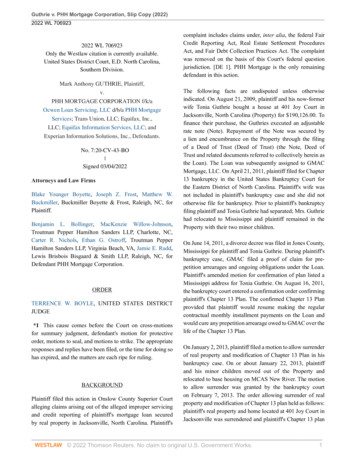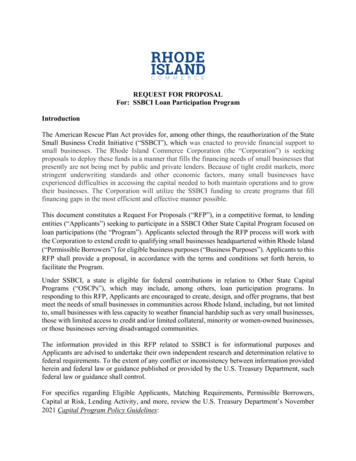
Transcription
Presenting a live 90-minute webinar with interactive Q&AStructuring Mortgage Loan ParticipationAgreements: Strategies for LeadLenders and ParticipantsDrafting Key Provisions, Conducting Lender Due Diligence, Managing Risk; "True Sale" and PerfectionTHURSDAY, JULY 6, 20171pm Eastern 12pm Central 11am Mountain 10am PacificToday’s faculty features:Alison R. Manzer, Partner, Cassels Brock & Blackwell, TorontoJames C. Schulwolf, Partner, Shipman & Goodwin, Hartford, Conn.The audio portion of the conference may be accessed via the telephone or by using your computer'sspeakers. Please refer to the instructions emailed to registrants for additional information. If youhave any questions, please contact Customer Service at 1-800-926-7926 ext. 10.
Tips for Optimal QualityFOR LIVE EVENT ONLYSound QualityIf you are listening via your computer speakers, please note that the qualityof your sound will vary depending on the speed and quality of your internetconnection.If the sound quality is not satisfactory, you may listen via the phone: dial1-866-873-1442 and enter your PIN when prompted. Otherwise, pleasesend us a chat or e-mail sound@straffordpub.com immediately so we canaddress the problem.If you dialed in and have any difficulties during the call, press *0 for assistance.Viewing QualityTo maximize your screen, press the F11 key on your keyboard. To exit full screen,press the F11 key again.
Continuing Education CreditsFOR LIVE EVENT ONLYIn order for us to process your continuing education credit, you must confirm yourparticipation in this webinar by completing and submitting the AttendanceAffirmation/Evaluation after the webinar.A link to the Attendance Affirmation/Evaluation will be in the thank you emailthat you will receive immediately following the program.For additional information about continuing education, call us at 1-800-926-7926ext. 35.
Program MaterialsFOR LIVE EVENT ONLYIf you have not printed the conference materials for this program, pleasecomplete the following steps: Click on the symbol next to “Conference Materials” in the middle of the lefthand column on your screen. Click on the tab labeled “Handouts” that appears, and there you will see aPDF of the slides for today's program. Double click on the PDF and a separate page will open. Print the slides by clicking on the printer icon.
Mortgage Loan Participation: AgreementsStructuring Strategies for Lead Lenders and ParticipantsJuly 6, 201755SHIPMAN & GOODWIN
SpeakersAlison R. ManzerCassels Brock & Blackwellamanzer@casselsbrock.com66James C. SchulwolfShipman & Goodwin LLPjschulwolf@goodwin.comSHIPMAN & GOODWIN
Our Program 71. Overview of loan participations (Alison Manzer)A. Market trends in Mortgage FinanceB. What is a "participating interest?" -.C. What are the key characteristics of a participating mortgageD. Benefits of Participation in Mortgage Lending2. Key participation agreement provisions and how they differ from Syndications (Jim Schulwolf)A.Sale, Funding Mechanics and SettlementsB. Default by Participant or LeadC. Voting RightsD. Notices and Repurchase RightsE. Seller reps and warrantiesF. Borrower DefaultG. Servicing, Standard of Care, Exculpatory Provisions and Reliance, and Regulatory ConcernsH. Managing Mortgage Investment3. Specific considerations for True Sale(Jim Schulwolf)Documenting a "true sale" of the underlying loanSHIPMAN & GOODWIN
Our Program (continued)4. Lender due diligence (Alison Manzer)A. Understanding and reducing the selling counterparty risksB. Considering the participation structure and lender right risksC. How much do you review of the deal and how much do you rely on representationsD. Mortgage issues and problems5.FDIC FIL492015 (Jim Schulwolf)A. Advisory on Effective Risk Management Practices for Purchased Loans and Purchased Loan8SHIPMAN & GOODWIN
Overview of Mortgage Loan Participations1A. Market Trends Unique characteristics of participation affect risk and marketrequirements: Seller remains lender of record and services the loan Buyer faces both underlying obligor and participation seller9SHIPMAN & GOODWIN
1A.Market TrendsParticipation as a Solution to Settlement Issues Settlement backlogs of leveraged loan secondary trading Implications of delayed resettlement Liquidity risk Market risk Delayed compensation Liquidity management requirements would affect loan trading: Minimum percentage of NAV be invested in “three-day liquid assets” i.e. assets convertible to cash in 3 business days at a price that does notmaterially affect the value of the asset immediately prior to sale10SHIPMAN & GOODWIN
1A.Market TrendsMitigants to delayed settlement: Liquidity facilities T 3 settlement facilities LSTA proposed changes to delayed compensation Buy-in / Sell-out mechanismParticipation Fall-back for assignments Primary transfer settlement option11SHIPMAN & GOODWIN
1A.Market TrendsOther Market Trends Affecting Participation in Loans byParticipation Are: 12Growing participation in the market by smaller shops with less backroomcapacityTighter regulations regarding counter-parties forcing participating lendersinto relationships with known and larger originators – allows more relianceClosing gaps in the terms for syndicated deals and participations makes thechoice more naturalGrowing appetite for investments is not always accompanied byadministrative capability making participation attractiveMore foreign investment drives choices to participation for regulatory andmanagement reasonsSHIPMAN & GOODWIN
1B.What is a Participation InterestWhat is a “participating interest”? Sale of an undivided interest in the rights of the selling lender; usually an economic 13interest onlyParticipant is not a direct creditor of the borrowerParticipant does not get the benefit of protections such as yield or gross up based ontheir statusNo common law rights such as set-offExposure to status of the selling lenderReliance issues for expert work such a opinionsUsually limited right to assignNo rights to direct enforcement or other actionsLimited rights to vote and agree on amendmentsSHIPMAN & GOODWIN
1B.Defining a ParticipationStructures for Participations 14Club Format – usually purely economicAssignment and Assumption – with Notice and AcknowledgementIndirect Participation – or a Participation in a ParticipationCo-lending – only one level RemoteSyndication – with intervening agency issuesSHIPMAN & GOODWIN
1C. Key CharacteristicsTransfer is done using a participation agreement with certificates issuedParticipation agreement governs as between the selling lender and participant butdoes not affect the credit agreement – participant acts through the selling lender onlyParticipant interest is an economic interest through the selling lenderPayments are seldom direct – they come through the selling lenderThe lender rights, even if lender status specific, are only those of the selling lender,indirect for participantOutright sale with only relationship as to agency or trustee as agreed in theparticipation agreementNo borrower relationship; can be anonymous, no obligationsNo registration issues; no direct mortgage responsibilityDeals with mortgage title issuesAllows participation despite regulatory restrictions15SHIPMAN & GOODWIN
1D.Benefits of ParticipationFOR SELLING LENDER Diversifying risk while retaining client relation and administration control Leveraging income by reducing capital out and gaining fees Reducing capital weight / lending limits Building client relationships by accessing larger loans Collecting fees for arranging and administering loan Not recorded as liability on balance sheet to the extent sold Control by selling lender is usually greater than other syndicate structures16SHIPMAN & GOODWIN
1D.Benefits of ParticipatingFOR PARTICIPANTS 17Access to deal flowAccess to lead lender’s capabilitiesStay within credit limitsConfidentiality (identity of participants not known to Borrower)No consent of Borrower requiredLower administrative costsLower due diligence and loan closing costsLess administrative burdenEliminates mortgage title holding issuesIncreased ability to access mortgage returnsSHIPMAN & GOODWIN
1D.Benefits of ParticipatingFOR BORROWER 18Borrower only has to deal with LeadLower costs by reducing registration costsReal estate based covenants easier to deal withConsistency of lender approachSHIPMAN & GOODWIN
2. Key Differences Between Participation andSyndication Participation A lender makes a loan to the borrower(s) and then sells“undivided interests” in the loan to participants The participants have no interest in the collateral other thanreceiving their pro-rata share should the lender liquidate Advances are made by the lender and the participants“settle up” There is no privity between the participants and theborrower(s) No holding of title interests19SHIPMAN & GOODWIN
2. Key Differences Between Participation andSyndication Syndication Each lender extends credit to the borrower(s) under oneloan facility, with an agent acting on behalf of the colenders Typically, an agent holds the collateral for the loan and anagent for the co-lenders (often the same) administers theloan for the co-lenders Advances may be made directly by the co-lenders orthrough the agent The co-lenders are in privity with the borrower(s) Need for agency roles20SHIPMAN & GOODWIN
2A.Sale, Funding Mechanics, and Settlement Sale Undivided interest in all loans, fees and claims Not an independent loan from participant to borrower Funding Mechanics At closing, Participant pays its proportionate share of outstanding loanamount If additional loans (e.g. a revolving loan) must establish fundingmechanics Lead notifies participant in writing Specifies date and amount Participant pays on funding date Lead should determine whether conditions precedent to funding havebeen satisfied, but this can be negotiated21SHIPMAN & GOODWIN
2A.Sale, Funding Mechanics, and Settlement(continued)Funding Mechanics (continued) Repayments come to Lead and are typically remitted “promptly” to Participant Typically on day of receipt or next business day depending upon whenreceived by LeadIf an Event of Default, payments distributed under typical waterfall with Lead’scollection costs and expenses first, then fees, interest, principal, increasedcosts/break funding payments to Lead and ParticipantSettlements 22Lead and Participant can agree to periodic settlementsLender communicates amounts to be paid by or to ParticipantPayments reimbursed if dishonored after distribution to ParticipantIf disgorgement results in return of money to Borrower, Lead and Participant contributetheir pro rata shareSHIPMAN & GOODWIN
2B.Default by Participant or LeadDefault by Participant Participant fails to make its proportionate share ofadvance Lead can make advance and subordinate Participant Lead can recover from Participant Initially at Overnight Fed Funds date After a designated period (often 3 business days), atunderlying loan rate Any voting rights are suspended during default23SHIPMAN & GOODWIN
2B.Default by Participant or Lead (continued)Default by Lead Breach by Lead of its obligations under participationagreement Participant can withhold payment of advances Participant can recover any amount owed by Lead Initially at Overnight Federal Funds Rate After a designated period (typically 3 business days), at theunderlying loan rate24SHIPMAN & GOODWIN
2C.Voting RightsWhich decisions can be made solely by the Lead and whichrequire the consent of the Participant? 25“Full” Participation Participant consent required for any actions related to theloan, including amendments, waivers, consents, etc/“Silent” Participation Lender can take all actions without consent of ParticipantSHIPMAN & GOODWIN
2C.Voting Rights (continued)Middleground is more typical and typically incorporates“sacred rights” commonly seen in syndications Increasing principal amount of loanExtending maturity dateReducing interest rateMiddleground may also include Release of collateralRelease of guarantorWaiver of payment or financial covenant defaultsDecision to accelerate or exercise remediesLead maintains as much day-to-day freedom as it can26SHIPMAN & GOODWIN
2D.Notices and Repurchase RightsNotices Lead should provide all information received in connection withloan Not always done, which can create issues (and potentially liabilityissues) in a workout Can run through and be transmitted by Lead, or can be sentdirectly to Participant Consider use of electronic platforms (which are typically used insyndicated deals) Are they sufficient in all cases? Do they satisfy the Participant’s regulatory and internal policyrequirements? Who bears the risk if the notice is delivered (or not delivered),goes to the wrong party, or not read, etc.?27SHIPMAN & GOODWIN
2D.Notices and Repurchase Rights (continued)Repurchase Rights Lead typically can repurchase the participation upon thehappening of one or more triggering events Participant doesn’t agree to a requested amendment,consent, or waiver within an agreed period of time Similar to “yank-a-bank” provisions in syndicated deals Participant defaults Repurchase is typically at par Fees and costs, negotiable but not included if there’s aParticipant default28SHIPMAN & GOODWIN
2E.Representations and WarrantiesRepresentations by Lead are very limited Ownership, organization, authority, no violation, and outstandingloan amount Reps as to legality, enforceability, collectability and priority areexplicitly disclaimedParticipant representations are typically broader 29Organization, authority, enforceability, no consent, no violationAlso include purchase for own account, no intention to sell,compliance with laws (including legal lending limits), ability tobear economic risksSHIPMAN & GOODWIN
2F.Borrower Default When an Event of Default occurs, Participant will typically notknow about it independently Lead provides notice to Participant within agreed time period Typically within 3-10 business days after the Event ofDefault becomes known to Lead After expiration of notice and cure period When does Lead know about the Event of Default? Typically when a responsible officer becomes aware ofthe Event of Default Failure to give notice should not derogate from Lead’srights or Participant’s obligations30SHIPMAN & GOODWIN
2F.Borrower Default (continued)Who decides on taking post-default actions? Lead wants maximum flexibility Depending upon Participant’s leverage, Participant mayhave Full vote No vote at all Right to be consulted before action Right to be consulted as to possible actions Should Participant be consulted? May have internal policy or regulatory implications Mortgage remedies and how they effect31SHIPMAN & GOODWIN
2G. Servicing, Standard of Care, ExculpatoryProvisions and Reliance, and Regulatory Concerns Lead has exclusive responsibility for servicing loan No direct interaction between Participant and BorrowerLead’s books and records reflect participationStandard of Care Same as Lead’s own loansLead has very limited liability to Participant No liability for Exercise of reasonable discretion consistent with its own loans Good faith errors of judgment Reasonable discretion pursuant to loan documents Liability for Gross negligence or wilful misconduct Lead default32SHIPMAN & GOODWIN
2G. Servicing, Standard of Care, Exculpatory Provisionsand Reliance, and Regulatory Concerns (continued) May rely on counsel and other professional advisors with samestandards of liability and exculpation for their actions No fiduciary relationships between Lead and Participant Exculpatory provisions and Reliance Very broad in favor of lead No responsibility as to collectability, due execution, validity, orenforceability of loan documents, or as to Borrower reps, warranties orcovenants Participation issued without recourse, representation or warranty Participant responsible for its own underwriting and credit analysis –cannot rely on that of Lead No assumption by Lead of any responsibilities to Participant Express exoneration of Lead by Participant33SHIPMAN & GOODWIN
2G. Servicing, Standard of Care, Exculpatory Provisionsand Reliance, and Regulatory Concerns (continued) No warranties about financial status of Borrower or value of collateral Generally enforced but may in some cases be strictly construedagainst LeadRegulatory issues If regulatory issues are required to be considered, and informationand materials are required to be obtained and provided, thoseregulatory issues will generally require ongoing monitoring The nature of the reports which are required so regulatory issues canbe monitored need to be made clear by a Participant and appropriatearrangements need to be made to obtain, and provide on a timelybasis, the reports required by the Participant34SHIPMAN & GOODWIN
2G. Servicing, Standard of Care, Exculpatory Provisionsand Reliance, and Regulatory Concerns (continued) Timing for the provision of reports needs to take into account thespecific requirements of each Participant Credit assessment and ongoing credit review is important for eachParticipant. These requirements should be identified, andappropriate content and timing for delivery of these requirementsshould be scheduled and agreed to Participants must advise the Lead when changes occur as toinformation and materials which they require for regulatory purposesMortgage Rights and Remedies in the Context of a Syndicate35SHIPMAN & GOODWIN
2H. Managing Mortgage Investments in aSyndicate The issues that are unique to mortgage lending Timing differences for mortgage remedies – how thataffects the lender consent process Protective Advances by a syndicate for real estate(mortgages)36SHIPMAN & GOODWIN
3A.True Sale of Loan ParticipationsTrue sale issues reflect bankruptcy risk in participations: Is the participated loan an asset of the seller than can beavailable to satisfy claims of its creditors followingbankruptcy?Applicable US insolvency regimes 37Bankruptcy Code Chapter 11 (11 U.S.C. 365(f) & (h))FIRREAOrderly Liquidation AuthorityOthers may apply – e.g. state insurance receivership lawsSHIPMAN & GOODWIN
3A.True Sale of Loan Participations“True Participation” indicia: Participation “without recourse” to seller;Same term as the underlying asset;No commingling of proceeds;Seller must turn over collections on underlying asset;Intent to effect a sale and not an extension of credit.Accounting treatmentDifference between LSTA vs. LMA documentsCircumstances when a “true sale” opinion may be needed Rating agency requirements applicable to buyer Regulatory capital requirements Accounting sale – FAS 16638SHIPMAN & GOODWIN
3A. True Sale of Loan ParticipationsAlternatives to true sale for obtaining proceeds ofparticipated loan from insolvent seller under US law: Bankruptcy Code section 741: “Securities contract” Bankruptcy Code section 541(b)(1): Loan participant considered beneficial owner ofgrantor’s rights in the underlying loan Characterization is supported by automatic perfection of“payment intangibles” under UCC section 9-30939SHIPMAN & GOODWIN
4.Lender Due DiligenceUnderwritingKnow Your PolicyThe loan participation policy must establish prudent underwriting standards for loanparticipations.Established appropriate due diligence Can be done in-house or through a qualified third party that is not affiliated withthe loan May NOT rely on originating lender’s due diligenceExaminers will evaluate: The FI’s parameters for review How often the parameters are analyzed How well the originator adheres to its own policiesReal Estate Specific Requirements Usual requirements – reviews, LTV and more Title issues and support Environmental40SHIPMAN & GOODWIN
4A.Lender Due Diligence – Counterparty Risk Understanding the Reason why Participations are sold and theIssues to Be Identified as a Result How to Ensure that Regulatory Requirements are Suitably met by theDuties and Responsibilities of the Agent How to Balance Risk Among the Participants and Selling Lender Understanding the Need for Due Diligence as to the Selling Lender,Agent, Co-Lenders, and the Borrower in the Structure Regulatory requirements and the ability to rely on the selling lender Credit review and the ability to rely on the selling lender Real estate and mortgage considerations Management experience matters Environmental exposure41SHIPMAN & GOODWIN
4B.Lender Due Diligence – Structure and LenderRights – Participation within a Syndicate Participants are reliant on both the selling lender and any syndicationagent The exculpatory clauses of the credit agreement will impact both theselling agent and indirectly the participant Exculpatory clauses were originally designed to reduce the risk to theagent with regard to responsibilities syndicate lenders and theundertaking of its duties and to reduce cost of the agency roleaccordingly. Exculpatory clauses are increasingly draconian as drafting has resultedin agents being protected from liability for essentially all of the duties The impact of real estate and mortgage security must be considered The issue of mortgage “dabbling” and reliance Realization issues and rights42SHIPMAN & GOODWIN
4. Lender Due Diligence – Structure - SecuritiesLaw Issues The broad range and reach of Securities Law, and its application to debt financing,requires consideration at the stage of initiation of the transaction and formation of thesyndicate, different syndicate members maybe subjected to different securities lawrequirements and the extent and nature of these requirements need to be identifiedunder appropriate information obtained on a timely basis. Issues specific to the Borrower group and transaction such as increased exposure toregulatory issues based upon product, industry, environmental concerns need to beidentified. The specific requirements of syndicate participants’ check list understood, anddeliveries organized to ensure regulatory compliance by the Borrower group andreceipt of the required regulatory based information by the syndicate. Real estate specific concerns.43SHIPMAN & GOODWIN
4. Lender Due Diligence – Structure and LenderRights Selling lenders and Agents want to have little or no duties orresponsibility lenders Access to the Borrower group is restricted while regulatory andinternal policy requirements dictate the need for timely accurateinformation and assessments. The selling lender frequently has an existing, rapidly growing,relationship with the Borrower group which the balance of thesyndicate group does not have. Participant is not in a position touse judgement to assess the materials and information which isprovided to them either as to the extent, content, or accuracy.44SHIPMAN & GOODWIN
4.4Lender Due Diligence – How Much Do YouReview the DealCollect and Review 45Reports and audited financialsManagement assessmentLoan / Underwriting Policies and PracticesRepossession Policies and ProceduresLoan Modification and Nonaccrual PolicyCharge-off PolicyCollateral Insurance PolicySample Reporting PackageKnow Your “Debt”Understanding revenue sources and protectionEnvironmental reviewAccess, flood, expropriationSHIPMAN & GOODWIN
4. Lender Due Diligence – Review orRepresentationsTypically Limited Accuracy of loan documents Payments made to date No outstanding default Typically selling lender will require representation fromParticipants that they have done own credit analysis regardingBorrower, effectiveness of loan documents, adequacy ofcollateral, priority and perfection of security interest. The mortgage diligence package46SHIPMAN & GOODWIN
4.Lender Due Diligence - Credit Monitoring Increasingly lenders, particularly regulated financial institutions, are required toundertake credit monitoring beyond the simple identification of the occurrence of adefault. The differences in required reporting can be significant and will need to be reconciled,participant has no say. The nature of the ongoing credit monitoring packages need to be determined, wheremark-to-market requirements exist these must be identified and the basis fordetermining mark-to-market negotiated. Credit monitoring ties into the representations and warranties, the requirements forongoing credit monitoring should be taken into account when setting the financial andother representations, warranties and covenants.47SHIPMAN & GOODWIN
4.Lender Due Diligence - Regulatory Issues Regulatory requirements for any money laundering and anti-terroristfinancing, Patriot Act (etc.) requirements must be identified early, check listprepared, information obtained, and the basis for information direct orindirect identified. Participant is removed from the “detail” but still responsible – no “out” forbeing remote Participant needs to ensure timely information deliveries to satisfy regulatoryreporting The acceptability of the remote information flow against regulatory filing andmonitoring requirements needs to be determined; usually ok if strong agent,selling lender in same sector – otherwise maybe not48SHIPMAN & GOODWIN
4. Lender Due Diligence - Board PolicyComponents Underwriting standards for participated loans Limits on the aggregate amount purchased from any single originating lender of any loan type loans to any single borrower or group of associatedborrowers Risk Assessment and Strategic Planning Risk Measurement, Monitoring and Control Due Diligence49SHIPMAN & GOODWIN
4D. 50Mortgage Issues and ProblemsInsurance – scope and protectionsEnvironmental issuesRealization process and restrictionsFlood riskAccess issuesExpropriation risk and rightsSHIPMAN & GOODWIN
5.Advisory on Effective Risk Management Practices for PurchasedLoans and Purchased Loan Participations FDIC FIL-49-2015Key Concept: “It’s on you” Some FI’s are relying on lead or originating institutions andthird parties to perform risk management functions whenpurchasing loans and loan participations, including out-ofterritory loans, loans to industries or loan types unfamiliar tothe buyer, unsecured loans, or loans underwritten usingproprietary models. FDIC expects lenders to exercise sound judgment whenbuying loans and loan participations51SHIPMAN & GOODWIN
5.Advisory on Effective Risk Management Practices for PurchasedLoans and Purchased Loan Participations FDIC FIL-49-2015 Buyers should underwrite and administer loan and loanparticipation purchases as if the loans were originated bythe purchasing institution. This includes understandingthe loan type, the obligor’s market and industry, and thecredit models relied on to make credit decisions.52SHIPMAN & GOODWIN
5.Recommended PracticesEstablish policies and procedures Define acceptable loan types Establish concentration limits Aggregate purchased loans Out-of-territory loans Loans from one lead53SHIPMAN & GOODWIN
5.Recommended PracticesIndependent credit analysis Act as if it is the originator Be sure it has the requisite expertise Obtain information from lead/seller Determine Board’s cost appetite Do not outsource this to a third party If you rely on a third-party credit valuation model, you mustreview it to be sure it is sufficient54SHIPMAN & GOODWIN
5.Recommended PracticesProfit analysis Conduct profitability analysis May require additional costs (e.g. loan review personnel) Assess rate of return relative to risk taken55SHIPMAN & GOODWIN
5.Recommended PracticesParticipation Agreements 56Must be in writingShould contain standard provisions Roles and responsibilities Requirements for obtaining timely information and reports, including ongoingcredit information Remedies Voting rights Dispute resolution proceduresMust assess and understand the key termsUnderstand limitations on your institution Not making additional advance What if lead’s credit rating goes down?Seek counsel to review agreements prior to finalizingSHIPMAN & GOODWIN
5.Recommended PracticesAssess ability to sell, transfer or assign interests Should not limit ability to transfer if necessary for safety andsoundness or to comply with regulatory requirementsDue Diligence 57Perform extensive due diligence and monitoring of out-of-territoryparticipation or participations in unfamiliar industriesMonitor changing economic conditionsPerform prior to entering a third-party relationship Determine whether third-party has the financial capacity tomeet its obligations to you Check its reputation and compliance historyFDIC doesn’t endorse models, etc., so cannot rely on claims tothe contrarySHIPMAN & GOODWIN
5.Recommended PracticesInternal Functions Report purchased interests in accordance with GAAP Incorporate into audit and loan review program Obtain needed Board and Committee approvals, beforeentering into third-party arrangements Reports to Board must adequately cover activity,performance, and risk of purchased participations Ensure continuing compliance with Bank Secrecy Act andAnti-Money Laundering requirements58SHIPMAN & GOODWIN
SpeakersAlison R. ManzerCassels Brock & Blackwellamanzer@casselsbrock.com5959James C. SchulwolfShipman & Goodwin LLPjschulwolf@goodwin.comSHIPMAN & GOODWIN
Real estate based covenants easier to deal with Consistency of lender approach . 19 SHIPMAN & GOODWIN 2. Key Differences Between Participation and Syndication Participation A lender makes a loan to the borrower(s) and then sells "undivided interests" in the loan to participants
